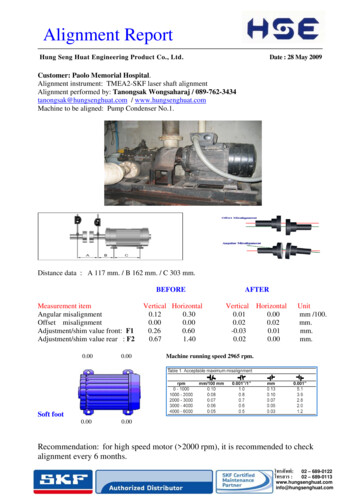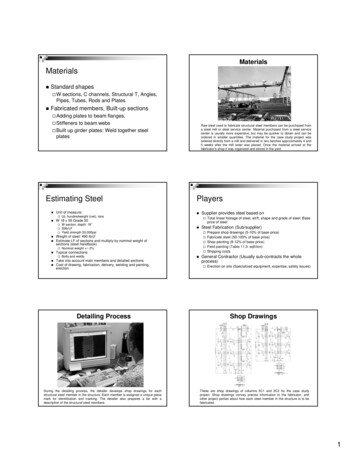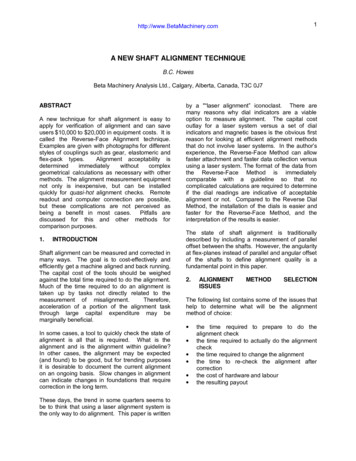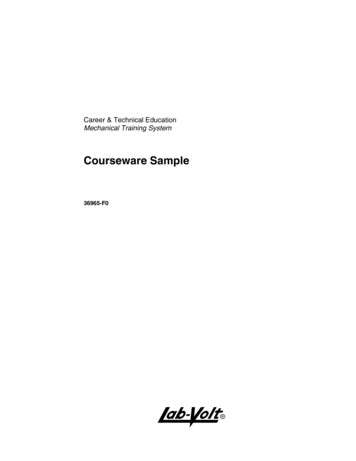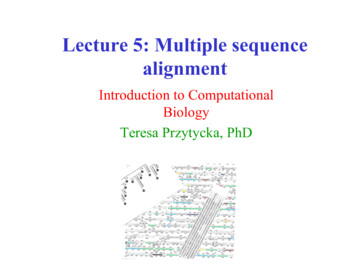
Transcription
Lecture 5: Multiple sequencealignmentIntroduction to ComputationalBiologyTeresa Przytycka, PhD
Why do we need multiple sequencealignmentPairwise sequence alignment for moredistantly related sequences is not reliable- it depends on gap penalties, scoringfunction and other details- There may be many alignments with thesame score – which is right?- Discovering conserved motifs in a proteinfamily
Multiple alignment as generalizationof pairwise alignmentS1,S2, ,Sk a set of sequences over the same alphabetAs for the pair-wise alignment, the goal is to findalignment that maximizes some scoring function:M Q P I L LPM L R – L- PM P V I L KPHow to score such multiple alignment?
Sum of pairs (SP) scoreExample consider all pairs of letters in eachcolumn and add the scores:( )SP-scoreAVV- score(A,V) score(V,V) score(V,-) score(A,-) score(A,V)k sequences gives k(k-1)/2 addendsRemark:Score(-,-) 0
Sum of pairs is not prefect scoringsystemNo theoretical justification for the score. In the example below identical pairs arescored 1 and different 0.A A A AA A A AA A A AA A A IA A I IA II I----------------------15 10 7 6
Entropy based score (minimum)-Σ(cj/C)jlog (cj/C)cj- number ofoccurrence of aminoacid j in the columnC – number of symbolsin the columnA A A A AA A A A IA A A A KA A A I LA A I I SA II I W----------------------0 .44 .65 .69 1.79(in the example natural ln)
Dynamic programming solution formultiple alignmentRecall recurrence for multiple alignment:{Align(S1i,S2j) maxAlign(S1i-1,S2j-1) s(ai, aj)Align(S1i-1,S2j) -gAlign(S1i,S2j-1) -gFor multiple alignment, under max we have all possiblecombinations of matches and gaps on the last positionFor k sequences dynamic programming table will have size nk
Recurrence for 3 sequencesAlign(S1i,S2j, S3k) max(0,0,0){Align(S1i-1,S2j-1, S3k-1) s(ai, aj, ak)Align(S1i-1,S2j , S3k-1) s(ai, -, ak)Align(S1i,S2j-1 , S3k-1) s( -, aj, ak)Align(S1i-1,S2j-1, S3k) s(ai, aj, -)Align(S1i,S2j, S3k-1) s(ai, -, -)Align(S1i,S2j-1, S3k) s(-, aj, -)Align(S1i-1,S2j, S3k) s(-, -, ak )optimal(n,n,n)
In dynamic programming approach running timegrows elementally with the number of sequences Two sequences O(n2) Three sequences O(n3) k sequences O(nk)Some approaches to accelerate computation: Use only part of the dynamic programming tablecentered along the diagonal. Use programming technique known as branch andbound Use heuristic solutions
Heuristic approaches to multiplesequence alignment Heuristic methods: Star alignment Progressive alignment methodsCLUSTALWT-CofeeMUSCLE Heuristic variants of Dynamic Programming Approach Genetic algorithms Gibbs sampler Branch and bound
Star alignment - using pairwise alignmentfor heuristic multiple alignment Choose one sequence to be the centerAlign all pair-wise sequences with the centerMerge the alignments: use the center as reference.Rule “once a gap always a gap”ACT ACT A-CTACTTCT-C T ATCT ACTFirst merging:Second mergingACTA-CTTCTT-CT-CT- -CTATCTthird mergingA-CTT-CT--CTATCTA-CT
Merging the sequences in stairalignment : Use the center as the “guide” sequence Add iteratively each pair-wise alignment to the multiplealignment Go column by column:– If there is no gap neither in the guide sequence in the multiplealignment nor in the merged alignment (or both have gaps)simply put the letter paired with the guide sequence into theappropriate column (all steps of the first merge are of this type.– If pair-wise alignment produced a gap in the guide sequence,force the gap on the whole column of already aligned sequences(compare second merge)– If there us a gap in added sequence but not in the guidesequences, keep the gap in the added sequence
Larger example
Two ways of choosing the center1. Try all possibilities and choose the resultingalignment that gives highest score; or2. Take sequence Sc that maximizesΣ i different than c pairwise-score(Sc ,Si)(need to compute all pairwise alignments)
Progressive alignment Idea:– First align pair(s) of most closely relatedsequences– Then interactively align the alignments toobtain an alignment for larger number ofsequences
- TCT- -CTA -CTATCTA - CTATCTACTATCTTCT- CTTCTCT
Aligning alignmentsDynamic programming where a column in eachalignment is treated as sequence elementA IA LAVK A- ALLAAScore of a match – scorefor the composite column
AA0AV00LL0AA0IL0K0AA0gapgapscore for columnwith I L L LGaps:as for sequencesMatch for position (i,j):Alignment score for thecolumn composed fromcolum i in the firstsequence and column j inthe second sequence
Deciding on the order to merge thealignment You want to make most similar sequencesfirst – you are less likely to miss-align them. After you align more sequences thealignment works like a profile and youknow which columns are to be conserved ina given family – this helps in correctalignment of more distant family members
CLASTALW“CLUSTAL W: improving the sensitivity of progressive multiple sequence alignment through sequenceweighting, position-specific gap penalties and weight matrix choice” Julie D. Thompson, Desmond G.Higgins and Toby J. Gibson*Nucleic Acids Research, 1994, Vol. 22, No. 22 4673-46801. Perform all pair pairwise alignments2. Use the alignment score to producedistance based phylogenic tree (phylogenictree constructed methods will be presented later in class)3. Align sequences in the order defined bythe tree: from the leaves towards the root.(Initially this involves alignment of sequencesand later alignment of alignments.)
Problems with CLUSTAL W andother “progressive alignments” Dependence of the initial pair-wisesequence alignment. Propagating errors form initial alignments.
ExampleThis and next figures examples are from T-coffee paper:Noterdame, Higgins, Heringa, JMB 2000, 302 205-217
T-Coffee (Tree-Based Consistency ObjectiveFunction for alignment Evaluation)Noterdame, Higgins, Heringa, JMB 2000, 302 205-217 Construct a library of pair-wise alignments– In library each alignment is represented as a list of pairwise residue matches (e.g.res.x sequence A is aligned withres. y of sequence B)– The weight of each alignment corresponds to percentidentity (per aligned residua)
T-coffee continued Consistency alignment: for every pair-wise alignments(A,B) consider alignment with third sequence C. What would bethe alignment “through” third sequence A-C-B Sum-up the weights over all possible choices if C to getConsistent with 2 alignments“extended library”.Consistent with 3alignments(higher score formuch)
Last step of T-coffee Do progressive alignment using the tree butusing the weights from extended library forscoring the alignment.(e.g. “A” in FAST will have higher score with “A”in FAT and lower with “A” in LAST.)
T-coffee summary More accurate than CLUSTALW Slower (significantly) the CLUSTALW butmuch faster than MSA and can handle moresequences.
A newer consistency based approachGenome research 2005
MUSCLERobert C. Edgar* Nucleic Acids Research,2004, Vol. 32, No. 5 1792-1797MUSCLE: multiple sequence alignmentwith high accuracy and high throughput
MUSCLE idea Build quick approximate sequence similarity tree –without pair-wise alignment but compute distancesby computing the number of short “hits” (shortgapless matching) between any pair of sequences. Compute MSA using the tree. Compute pair-wise distances from MSA and newtree Re-compute MSA using new tree Refine the alignment by iteratively partitioning thesequence into two groups and merging the aligningmultiple alignment from the two groups
Edgar, R. C. Nucl. Acids Res. 2004 32:1792-1797; doi:10.1093/nar/gkh340
Where the speed-up comes from Finding all short hits is fast due because wecan use methods like hashing ClustalW computed n(n-1)/2 pairwisealignments while given a tree one needs todo only n-1 alignments
Refining multiple sequence alignment Given – multiple alignment of sequences Goal improve the alignment One of several methods:– Choose a random sentence– Remove from the alignment (n-1 sequences left)– Align the removed sequence to the n-1 remainingsequences.– Repeat Alternatively – (MUSCLE approach) the alignmentset can be subdivided into two subsets, the alignmentof the subsets recomputed and alignment aligned
Evaluating MSA Based on alignment of structures(e.g. BaliBase test set) Simulation: simulate random evolutionarychanges Testing for correct alignment of annotatedfunctional residues
T-Coffee (Tree-Based Consistency Objective Function for alignment Evaluation) Construct a library of pair-wise alignments – In library each alignment is represented as a list of pair-wise residue matches (e.g.res.x sequence A is aligned with res. y of sequence


